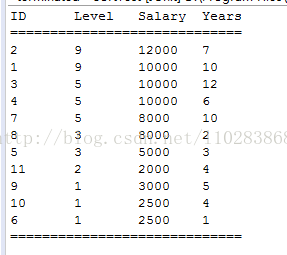转载请注明出处:http://blog.csdn.net/l1028386804/article/details/56513205
一、需求
假设现在有个如此的需求:需要对一个这样的雇员列表进行排序,排序规则如下:
1、首先级别最高的排在前面,
2、如果级别相等,那么按工资排序,工资高的排在前面,
3、如果工资相当则按入职年数排序,入职时间最长的排在前面。
雇员对象包含级别、工资和入职年份,代码如下:
package com.lyz.sort.bean;
import java.io.Serializable;
/**
* 雇员信息
* @author liuyazhuang
*
*/
public class Employee implements Serializable {
private static final long serialVersionUID = 4775629632953317597L;
/**
* ID
*/
public int id;
/**
* 级别
*/
public int level;
/**
* 工资
*/
public int salary;
/**
* 入职年数
*/
public int year;
public int getId() {
return id;
}
public void setId(int id) {
this.id = id;
}
public int getLevel() {
return level;
}
public void setLevel(int level) {
this.level = level;
}
public int getSalary() {
return salary;
}
public void setSalary(int salary) {
this.salary = salary;
}
public int getYear() {
return year;
}
public void setYear(int year) {
this.year = year;
}
public Employee(int id, int level, int salary, int year) {
this.id = id;
this.level = level;
this.salary = salary;
this.year = year;
}
}二、实现Comparator接口
这里我们实现Java.util.Comparator接口,用于对雇员列表进行排序,代码如下:
package com.lyz.sort;
import java.util.Comparator;
import com.lyz.sort.bean.Employee;
/**
* 核心排序类
* @author liuyazhuang
*
*/
public class EmpComparator implements Comparator<Employee> {
@Override
public int compare(Employee employee1, Employee employee2) {
int cr = 0;
//按级别降序排列
int a = employee2.getLevel() - employee1.getLevel();
if (a != 0) {
cr = (a > 0) ? 3 : -1;
} else {
//按薪水降序排列
a = employee2.getSalary() - employee1.getSalary();
if (a != 0) {
cr = (a > 0) ? 2 : -2;
} else {
//按入职年数降序排列
a = employee2.getYear() - employee1.getYear();
if (a != 0) {
cr = (a > 0) ? 1 : -3;
}
}
}
return cr;
}
}三、验证排序结果
下面用一个单元测试,来验证排序结果是否正确
package com.lyz.sort.test;
import java.util.ArrayList;
import java.util.Collections;
import java.util.List;
import org.junit.Test;
import com.lyz.sort.EmpComparator;
import com.lyz.sort.bean.Employee;
/**
* 测试排序类
*
* @author liuyazhuang
*
*/
public class SortTest {
@Test
public void sortTest() throws Exception {
List<Employee> employeeList = new ArrayList<Employee>() {
{
add(new Employee(1, 9, 10000, 10));
add(new Employee(2, 9, 12000, 7));
add(new Employee(3, 5, 10000, 12));
add(new Employee(4, 5, 10000, 6));
add(new Employee(5, 3, 5000, 3));
add(new Employee(6, 1, 2500, 1));
add(new Employee(7, 5, 8000, 10));
add(new Employee(8, 3, 8000, 2));
add(new Employee(9, 1, 3000, 5));
add(new Employee(10, 1, 2500, 4));
add(new Employee(11, 2, 2000, 4));
}
};
Collections.sort(employeeList, new EmpComparator());
System.out.println("ID\tLevel\tSalary\tYears");
System.out.println("=============================");
for (Employee employee : employeeList) {
System.out.printf("%d\t%d\t%d\t%d\n", employee.getId(), employee.getLevel(), employee.getSalary(),
employee.getYear());
}
System.out.println("=============================");
}
}

四、附录
java.util.Comparator接口源代码
/*
* Licensed to the Apache Software Foundation (ASF) under one or more
* contributor license agreements. See the NOTICE file distributed with
* this work for additional information regarding copyright ownership.
* The ASF licenses this file to You under the Apache License, Version 2.0
* (the "License"); you may not use this file except in compliance with
* the License. You may obtain a copy of the License at
*
* http://www.apache.org/licenses/LICENSE-2.0
*
* Unless required by applicable law or agreed to in writing, software
* distributed under the License is distributed on an "AS IS" BASIS,
* WITHOUT WARRANTIES OR CONDITIONS OF ANY KIND, either express or implied.
* See the License for the specific language governing permissions and
* limitations under the License.
*/
package java.util;
/**
* A {@code Comparator} is used to compare two objects to determine their ordering with
* respect to each other. On a given {@code Collection}, a {@code Comparator} can be used to
* obtain a sorted {@code Collection} which is <i>totally ordered</i>. For a {@code Comparator}
* to be <i>consistent with equals</i>, its {code #compare(Object, Object)}
* method has to return zero for each pair of elements (a,b) where a.equals(b)
* holds true. It is recommended that a {@code Comparator} implements
* {@link java.io.Serializable}.
*
* @since 1.2
*/
public interface Comparator<T> {
/**
* Compares the two specified objects to determine their relative ordering. The ordering
* implied by the return value of this method for all possible pairs of
* {@code (lhs, rhs)} should form an <i>equivalence relation</i>.
* This means that
* <ul>
* <li>{@code compare(a,a)} returns zero for all {@code a}</li>
* <li>the sign of {@code compare(a,b)} must be the opposite of the sign of {@code
* compare(b,a)} for all pairs of (a,b)</li>
* <li>From {@code compare(a,b) > 0} and {@code compare(b,c) > 0} it must
* follow {@code compare(a,c) > 0} for all possible combinations of {@code
* (a,b,c)}</li>
* </ul>
*
* @param lhs
* an {@code Object}.
* @param rhs
* a second {@code Object} to compare with {@code lhs}.
* @return an integer < 0 if {@code lhs} is less than {@code rhs}, 0 if they are
* equal, and > 0 if {@code lhs} is greater than {@code rhs}.
* @throws ClassCastException
* if objects are not of the correct type.
*/
public int compare(T lhs, T rhs);
/**
* Compares this {@code Comparator} with the specified {@code Object} and indicates whether they
* are equal. In order to be equal, {@code object} must represent the same object
* as this instance using a class-specific comparison.
* <p>
* A {@code Comparator} never needs to override this method, but may choose so for
* performance reasons.
*
* @param object
* the {@code Object} to compare with this comparator.
* @return boolean {@code true} if specified {@code Object} is the same as this
* {@code Object}, and {@code false} otherwise.
* @see Object#hashCode
* @see Object#equals
*/
public boolean equals(Object object);
}




 本文介绍了一个雇员列表的排序需求及其实现方法。通过定义雇员类并实现Comparator接口,可以按照级别、工资和入职年份对雇员进行排序。
本文介绍了一个雇员列表的排序需求及其实现方法。通过定义雇员类并实现Comparator接口,可以按照级别、工资和入职年份对雇员进行排序。

















 1394
1394

 被折叠的 条评论
为什么被折叠?
被折叠的 条评论
为什么被折叠?










